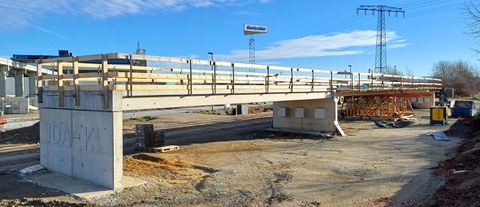Automatisierte Bewertung der Monitoringdaten
Inhaltsverzeichnis
Projektdaten
|
Titel | Title |
Bericht aus dem Jahrbuch 2023
Eine Forschungsbrücke in der Lausitz

Bauzustand des openLABs im Dezember 2023
Ein digitaler Zwilling gilt als virtuelles Abbild eines realen Objekts. An Ingenieurbauwerken, wie z. B. Brücken, können Messsysteme eingesetzt werden, um zu jedem Zeitpunkt eine Aussage zum Bauwerkszustand zu ermöglichen. So ist es zukünftig möglich, Schäden am Bauwerk frühzeitig zu detektieren, um Folgeschäden und ggf. daraus resultierende verkehrliche Einschränkungen zu verhindern. Aufgrund fehlender Ansätze für eine automatisierte Datenaus- und -bewertung stellen die zu verarbeitenden großen Datenmengen derzeit jedoch eine Herausforderung dar.
Hier setzt das Konsortium des Projekts IDA-KI an. Es werden Auswertemethoden entwickelt, die eine zuverlässige Differenzierung zwischen Messfehlern und Schäden am Bauwerk ermöglichen. Zur Validierung werden an einer 45 m langen Forschungsbrücke – openLAB – Belastungsversuche bis in den starken Schädigungszustand durchgeführt. Die so geschaffene Realdatenbasis enthält charakteristische Signale zu Schäden am Bauwerk, Messfehlern sowie Informationen zum Bauwerk im ungeschädigten Referenzzustand unter realen Umweltbedingungen.
Die Sensorik am openLAB wurde zum Teil schon vor der Betonage der Spannbetonfertigteile in der Schalung installiert, sodass ein Monitoring ab „Stunde null“ realisiert werden konnte. In Vorversuchen konnte die Eignung der Messtechnik erprobt werden. Von besonderer Bedeutung ist der Einsatz von verteilten faseroptischen Sensoren (DFOS), die mit einer Gesamtlänge von knapp 1 km ein künstliches Nervensystem der Brücke bilden. Die faseroptischen Sensoren ermöglichen eine quasi-kontinuierliche Dehnungsmessung, woraus beispielsweise Informationen zum Vorspanngrad oder zu einer möglichen Rissbildung abgeleitet werden können. Für eine teilautomatisierte Auswertung der großen Datensätze wurde die Programmbibliothek „fosanalysis“ entwickelt, die als freie Software zur Verfügung gestellt und im Rahmen des Projekts weiterentwickelt wird. Sämtliche Zustandsinformationen, inkl. der identifizierten Schäden, werden leicht konsumierbar in einem sogenannten As-maintained-Modell bereitgestellt.
Das openLAB soll im Februar 2024 fertiggestellt werden und wird auch externen Forschungsgruppen zur Verfügung gestellt, die Sensorik und Monitoringtechniken erproben und validieren möchten. Kooperationen mit den mFUND-Projekten smart_tendon und ANYTWIN sind bereits wirksam.
Bericht aus dem Jahrbuch 2022
Big data? Smart data!

Vorversuche an alten Brückenträgern – Installation der Dauerbelastung
Infrastrukturbauwerke unterliegen einer stetigen Alterung, weshalb ihr Zustand in regelmäßigen Intervallen händisch inspiziert werden muss. Erst wenn im Rahmen der turnusmäßigen Bauwerksprüfung ein Schaden festgestellt wird, wird eine Instandhaltungsmaßnahme geplant. Dieses reaktive Vorgehen führt dazu, dass Schäden oftmals lange unentdeckt bleiben und es infolgedessen zu erhöhten Sanierungskosten kommt. Zukünftig soll dieses problemorientierte Vorgehen durch ein datenbasiertes, vorrausschauendes und prädiktives Instandhaltungsmanagement abgelöst werden. Grundlage für eine zuverlässige Zustandsbewertung in nahezu Echtzeit ist das Bauwerksmonitoring. Aktuelle Monitoringanwendungen bedürfen jedoch aufwendiger manueller Auswertung, wobei eine Alterung der Messanlage oder Messfehler nur schwierig erkannt werden können.
Im Projekt IDA-KI werden mithilfe des maschinellen Lernens vollautomatisierte Bewertungsalgorithmen für Monitoringdaten entwickelt und in ein lebensdauerübergreifendes Monitoringkonzept ab Stunde null integriert. Die Algorithmen konnten für einen realen Datensatz einer Brücke bereits erfolgreich angelernt werden. Für die Fehlerdetektion und -bereinigung wird geprüft, welche Sensoren miteinander korrelieren. Treten bei einem Sensor starke Abweichungen im Vergleich zu den „Partnern“ auf, ist dies ein Indiz für einen Messfehler. Durch den Ansatz der analytischen Redundanz kann auf weitere redundante Sensoren oder ein numerisches Modell verzichtet werden.

Visualisierung des Reallabors
Aktuell wird eine Modellbrücke geplant, die baubegleitend mit Sensorik, z. B. mit faseroptischen Sensoren, ausgestattet werden soll. Dadurch können das Monitoringkonzept und die Auswertealgorithmen im Zeitraffer validiert werden. Durch Belastungstests sowie eine gezielte Schädigung redundanter Messtechnik wird erstmalig eine Realdatenbasis geschaffen, die zukünftig eine Unterscheidung zwischen Messfehlern, Einflüssen aus der Alterung der Messanlage und strukturellen Veränderungen am Bauwerk ermöglicht. Zustandsindikatoren sollen eine intuitive Interpretierbarkeit großer Datenmengen ermöglichen. Das Demonstratorbauwerk, welches in Bautzen errichtet wird, wird als Reallabor ausgebaut und dient auch nach der Projektlaufzeit als Ort des wissenschaftlichen Austauschs in der Kohleregion.
